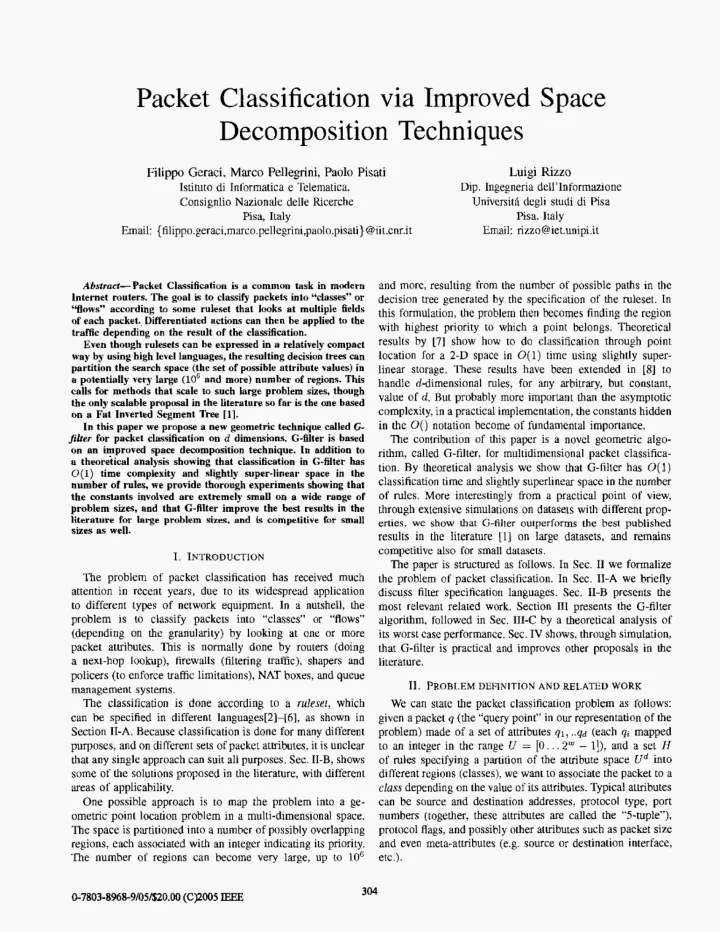

via Improved Space zyxwvutsrqponmlkjihgfedcbaZYXWVUTSRQPONMLKJIHGFEDCBA Packet Classification Email: zyxwvutsrqponmlkjihgfedcbaZYXWVUTSRQPONMLKJIHGFEDCBA { zyxwvutsrqponmlkjihgfedcbaZYXWVUTSRQPONMLKJIHGFEDCBA Decomposition Techniques Filippo Geraci, Marco Pellegrini. Paolo Pisati Luigi Rizzo Istituto di Informatica e Telematica. Dip. Ingegneria dell’hformazione Internet routers. The zyxwvutsrqponmlkjihgfedcbaZYXWVUTSRQPONMLKJIHGFEDCBA UniversitA degli studi di h a Consignlio Nazionale delle Ricerche Pisa, Italy Pisa, Italy filippo.geraci,marco.pellegrini,paolo.pisati} Email: rizzo@iet.unipi.it @ii t.cnr.it common task in modern Classification is a and more, resulting from the number of possible paths in the Abstract-Packet value of d. But probably more important zyxwvutsrqponmlkjihgfedcbaZYXWVUTSRQPONMLKJIHGFEDCBA goal is to classify packets into “classes” or decision tree generated by the specification of the ruleset. In “flowsTT according to some ruleset that looks at multiple fields this formulation, the problem then becomes finding the region In this paper we propose a new geometric technique called G- zyxwvutsrqponmlkjihgfedcbaZYXWVUTSRQPONMLKJIHGFEDCBA of each packet., Differentiated actions can then he applied to the with highest priority to which a point belongs. Theoretical filter for packet classification on zyxwvutsrqponmlkjihgfedcbaZYXWVUTSRQPONMLKJIHGFEDCBA traffic depending on the result of the classification. results by [7] show how to do classification through point Even though rulesets can be expressed in a relatively compact location for a 2-D space in O(1) time using slightly super- way by using high level languages, the resulting decision trees can partition the search space (the set o f linear storage. These results have been extended in @] possible attribute values) in to classification time and slightly superlinear space in zyxwvutsrqponmlkjihgfedcbaZYXWVUTSRQPONMLKJIHGFEDCBA a potentially very large (lo6 and more) number of regions. This handle ddimensional rules, for any arbitrary, but constant, calls for methods that sale to such large probIem sizes, though than he asymptotic the only scalable proposal in the literature so far is the one based on a Fat Inverted Segment Tree [I]. complexity, in a practical implementation, the constants hidden in the C l ( ) notation become of fundamental importance. d dimensions. G-filter is based The contribution of this paper is a novel geometric algo- on an +proved space decnmpasition technique. In addition to rithm, called G-filter. for multidimensional packet classifica- a theoretical analysis showing that classification in G-filter bas tion. By theoretical analysis we show that G-filter has O(1) O(1) time complexity and slightly super-linear space in the the number number of rules, we provide thorough experiments showing that of rules. More interestingly from a practical point of view. the constants involved are extremely small on a wide range of problem sizes, and that C-filter improve the best results in the through extensive simulations on datasets with different prop- literature for large problem sizes, and i s competitive for small erties, we show that G-filter outperforms the best published sizes as well. results in the literature [l] on large datasets, and remains competitive also for small datasets. I. INTRODUCTION The paper is structured as follows. In Sec. I1 we formalize the problem of packet classification. In Sec. 11-A we briefly The problem of packet classification has received much attention in recent years, due to its widespread application discuss filter specification languages. Sec. 11-B presents the to different types of network equipment. In a nutshell, the most relevant related work. Section I T 1 presents the G-filter algorithm, followed in Sec. 111-C by a theoretical analysis of problem is to classify packets into “classes” or “flows’’ problem) made of a set of attributes 91, zyxwvutsrqponmlkjihgfedcbaZYXWVUTSRQPONMLKJIHGFEDCBA its worst case performance. Sec. IV shows, through simulation, (depending on the granularity) by looking at one or more packet attributes. This is normally done hy routers (doing that G-filter is practical and improves other proposals in the a next-hop lookup), firewalls (filtering traffic), shapers and literature. policers (to enforce traffic limitations), NAT boxes, and queue 11. PRO3LEM DEFiNlTION AND RELATED WORK management systems. The classification is done according to a ruleset, which We can state the packet classification problem as follows: given a packet g (the “query point” in our representation of the can be specified in different languages[2]-[6], as shown in Section 11-A. Because classification is done for many different ..qd (each qi mapped purposes, and on different sets of packet attributes. it is unclear .2” - and a set H to an integer in the range U = [ O . . l]), of rules specifying a partition of the attribute space Ud into that any single approach can suit all purposes, Sec. 11-B, shows different regions (classes). we want to associate the packet to a some of the solutions proposed in the literature, with different class depending on the value of its attributes. Typical attributes areas of applicability. One possible approach is to map the problem into a ge- can be source and destination addresses. protocol type, port numbers (together, these attributes are called the “5-tuple”), ometric point location problem in a multi-dimensional space. The space is partitioned into a number of possibly overlapping protocol flags, and possibly other attributes such as packet size and even meta-attributes (e.g. source or destination interface, regions, each associated with an integer indicating its priority. .I. The number of regions can become very large, up to lo6 etc 304 IEEE 0-7803-8%8-9/05/$20.D0 ( C ) 2 0 0 5
Recommend
More recommend